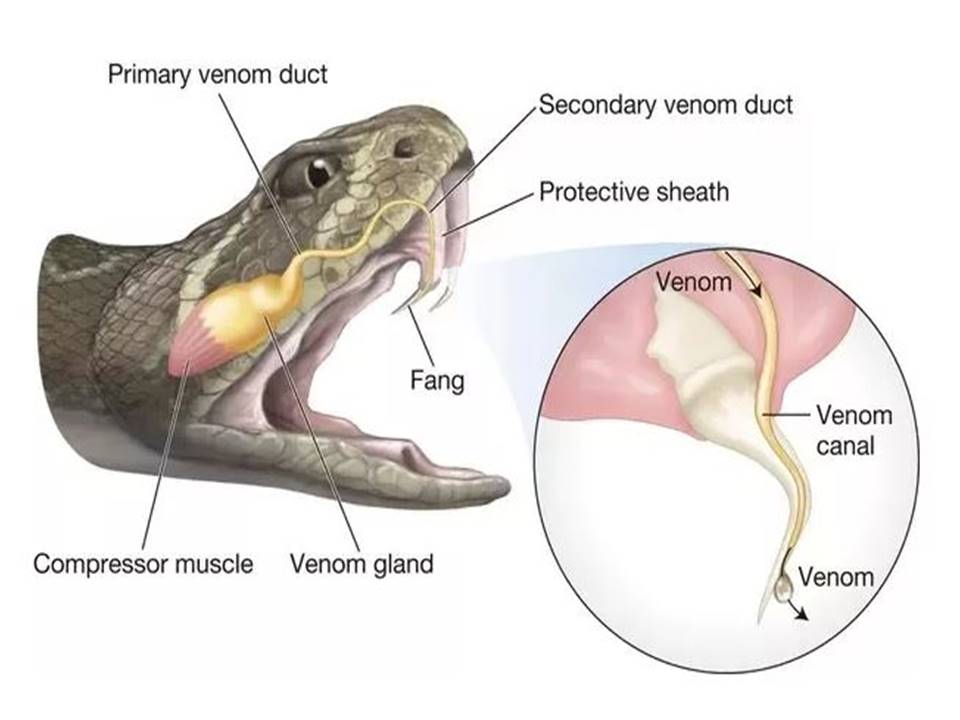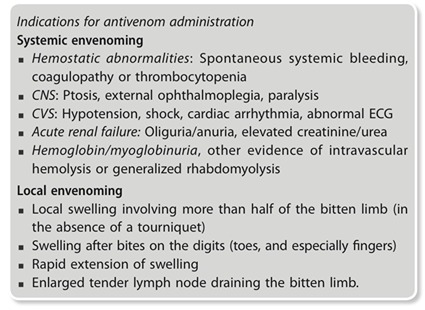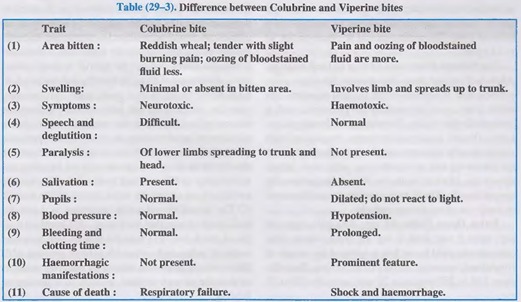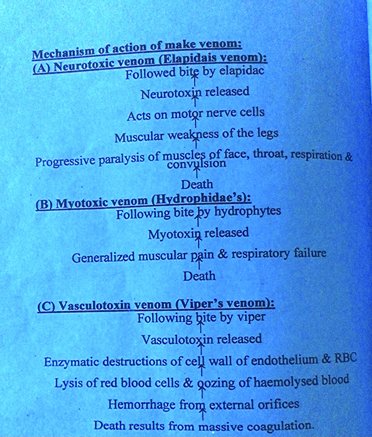
Classification of Snake
A. Non poisonous e.g. rat snake, vine snake, and mud snake.
B. Poisonous: ↓
| 1. Viperidae | Russell's viper Gaboon viper Saw scaled viper |
| 2. Crotalidae | Rattlesnakes Pigmy rattlesnakes Pit viper Copperheads Cottonmouths (water moccasins) Bushmaster |
| 3. Elapidae | Cobras Kraits Mambas Tiger snake Taipan Coral snakes |
| 4. Hydrophidae or sea snakes | All sea snakes are poisonous but they seldom(rarely) bite. |
| 5. Colubridae | Boomslangs Bird snake of the African continent. |
| 6. Atractaspididae | Burrowing asps Burrowing or mole vipers/false vipers |
COMMON POISONOUS SNAKES:
- Common Cobra
- The King Cobra
- Common Krait
- Banded Krait
- Russell’s Viper
- Saw-Scaled Viper
Poison Apparatus (Modified salivary gland)
- Gland
- Duct
- Fangs
Poison Glands:
They are the salivary glands of the snake and are situated behind the eyes, one on each side of the head above the upper jaw.
FANGS:
All the poisonous snakes have two fangs. These are curved teeth situated on the maxillary bones and lie along the jaws, and are covered by a flap of mucous membrane.
They are bigger than the other teeth and are grooved or canalized in poisonous snakes, and are solid in non-poisonous snakes.
SNAKE VENOM:
Venom is the saliva of the snake.
Cobra venom is faint transparent yellow and is slightly viscous. When exposed to sun, it becomes slightly turbid. Russell's viper venom is white or yellow.
Venom is secreted by special glands near the upper jaw of the snakes which are akin to human parotid glands. During the process of bite, the glands are pressed and the venom is squeezed and channelled through the grooves or channels of the fangs.
Composition of Snake Venom
It is basically a mixture of toxalbumins and enzymes in varying proportions. The enzymatic components cause local and systemic effects and the non-enzymatic compounds provide lethality .
Toxalbumin
- Neurotoxins
- Cardiotoxin
- Myotoxin
- Hemolysin
- Fibrinolysin
Enzymes
- Cholinesterase
- Hyaluronidase
- Proteolytic enzymes (Protease)
- Phospholipase A,B,C,D
- Lecithinases
- Ribonuclease
- Deoxyribonuclease
| The colubrine and Elapidae venom is mainly neurotoxic and has primary toxicity for the respiratory and cardiac centers. |
| The viperine venom is mainly hemotoxic and causes intravascular hemolysis and depression of the coagulation mechanism. |
| The sea snake venom is myotoxic. |
Ophitoxaemia is poisoning by snake venom.
Signs and Symptoms:
The most common symptom following a snake bite (poisonous or non-poisonous) is fright, especially the fear of rapid and unpleasant death.
Due to fright, the victim may become semiconscious with cold clammy skin, hypotension, feeble pulse, and rapid breathing. These emotional symptoms appear within a few minutes of the bite. Sometimes, it produces psychological shock and even death. It may also give rise to tetanus or gas gangrene.
Local signs and symptoms: (Ref Internet)
- Fang marks,
- Pain
- Swelling
- Edema & erythema
- Lymph node enlargement, blistering
Systemic (Ref Internet)
- Nausea and vomiting
- Diarrhea
- Paresthesias
- Cranial nerve palsies
- Flaccid muscles (including respiratory muscle paralysis)
- Hypotension & shock
- Oliguria

Difference between poisonous and non-poisonous snakes
| Trait | Poisonous snake | Non-poisonous snake |
| Head scales |
Small (in vipers)
Large (in others)
|
Usually large |
| Belly scales | Large and cover entire breadth. | Small or moderately large, but do not cover the entire breadth. |
| Fangs | Hollow like hypodermic needles | Short and solid |
| Teeth | Two long fangs | Several small teeth |
| Tail | Compressed | Not much compressed |
| Habits | Usually nocturnal | Not so |
Difference between cobra and viper
| Trait | Cobra | Viper |
| Head | Usually small, covered by large scales or shields of special forms. | Large; broader than body and covered by numerous small scales |
| Body | Long and cylindrical | ShortNarrow neck |
| Pupil | Round | Vertical |
| Maxillary bone | Carries poison fangs and other teeth | Carries only poison fangs |
| Fangs | Grooved, short, fine | Canalized, long |
| Venom | Neurotoxic | Hemotoxic |
| Tail | Round | Tapering |
| Eggs | Lay eggs | Give birth to young ones |

Polyvalent Anti-snake Venom (PAV) is prepared by hyper-immunizing horses against the venom of the four common poisonous snakes, i.e., cobra, common krait, Russell's viper and saw-scaled viper. Plasma obtained from the hyperimmunized horses is concentrated and purified.
It is useful when given within four hours of the bite. It is of less value if delayed for eight hours, and is of doubtful value after twenty-four hours. Each vial of PAV will neutralize about 6 to 8 mg of venom.
20 minutes blood clotting test :
Few ml. of fresh venous blood is put in a clean dry glass tube and left undisturbed for 20 minutes and then gently tilted. If the blood is still liquid, it indicates a viper bite. This test is repeated every 6 hours for determining the repeat dose requirement. Normalization of clotting time is taken as the endpoint of therapy. After that, the test is done at 12-hour intervals for at least 48 hours to detect recurring envenoming. Repeat dosing is required for recurrence of systemic signs.
First Aid in case of Snake Bite:
1) Assure the patient.
2) Apply firm pressure over the bitten area, which delays the absorption of venom.
3) Pressure immobilization is recommended for elapid and sea-snake bites, but not for viper bites as it may cause local necrosis.
Immediately apply a broad firm bandage on the bitten area and around the limb. As much of the limb should be bandaged as is possible. It should be tight enough to occlude the superficial venous and lymphatic return, but not the arterial or deep venous flow.
4) Immobilize the limb, as movement can accelerate the spread of venom. Avoid elevation of an extremity, as it may hasten systemic absorption of venom.
5) Local incision and suction should not be done as it can cause local bleeding and nerve injury.
6) Do not suck the venom out of the wound, and do not use chemicals or medicines on the wound.
7) Clean the wound with soap and water, or iodine and cover with a sterile dressing.
8) Make the patient lie on one side in the recovery position so that the airway is clear, in case of vomiting or fainting.
Management & Treatment of snake poisoning
A. Recommend first aid method
- Assurance the victim
- Immediately apply a broad firm bandage (Compression bandage) on the bitten area.
B. Quick Hospitalization
- Rapid clinical assessment & resuscitation (by ABCD): Airway, Breathing, Circulation, Dehydration
- Detailed History & Clinical assessment
- Circumstances of bite
- Site, Time of bite
- Progressive symptoms & signs (Local, Neurogenic, Hematological)
- Description of the bitten snake
C. Specific Treatment (Reddy)
| 1. Anti-venom Treatment Polyvalent Antisnake Venom |
| 2. Antibiotics Inject tetanus antitoxin or a booster dose of tetanus toxoid. A broad-spectrum antibiotic should be given if there is severe tissue involvement. |
| 3. If there are signs of neuroparalysis, give neostigmine with atropine i.v. to counteract the muscarinic effects |
| 4. In viper poisons, sedatives may be given to relieve pain and nervousness. |
| 5. Ventilator care Mechanical ventilatory support is necessary in respiratory failure. |
| 6. Hypotension & Shock In severe poisoning, infusion of normal saline or transfusion of blood or plasma are very useful. |
| 7. Hemostatic disturbances Heparin may be given i.v. if there are clotting abnormalities. |
| 8. Oliguria and renal failure Rehydration, Diuretic or dopamine Hemodialysis may be necessary. Peritoneal dialysis |
Complications: (Ref Internet)
- Compartment syndrome (Pressure within compartment restricting the blood flow)
- Tissue necrosis
- Coagulopathy (impaired clot formation) and spontaneous bleeding
- Paralysis & coma
- Hypotension & shock
- Respiratory Failure
- Renal Failure

Absorption and Excretion:
Snake venom is poisonous only when injected, and is harmless when taken by the mouth, as it will be digested by enzymes in the intestinal tract and absorbed as amino acids. It is excreted by kidneys, milk, and probably by salivary glands and the mucous membranes.
The Circumstances of Poisoning:
(1) Poisoning is as a rule accidental.
(2) Occasionally, a murder is committed by throwing a poisonous snake on the bed of a sleeping person.
(3) It is very rarely used for suicide.
(4) Cattle are sometimes poisoned by snake venom.
Postmortem Appearances:
Poisonous snakes leave two or occasionally one fang mark. Non-poisonous snakes leave a semicircular set of the tooth- marks.
Bite site might be swollen, redness, or hemolyzed blood stain
Washing from the bite area may contain cholinesterase or thromboplastin.
Kidneys are inflamed and show marked congestion.
Acute renal failure is the leading cause of death in viper bite.
Hemorrhages into the bowel, purpuric spots on the pericardium, and hemorrhages in the lungs and in many tissues may be seen.
Internal organs are congested.


Comments (0)